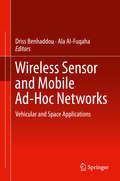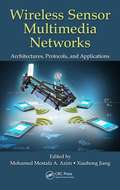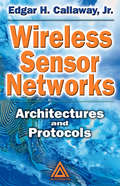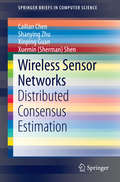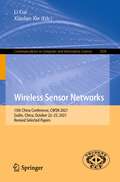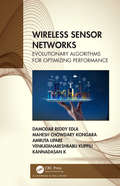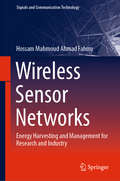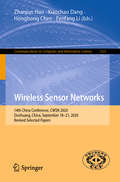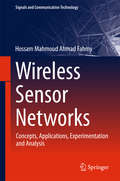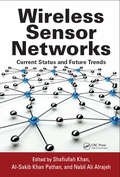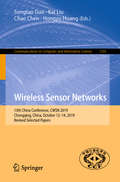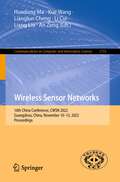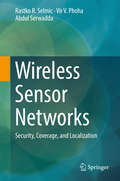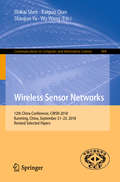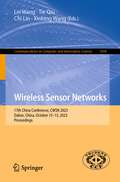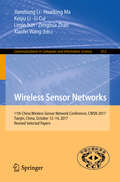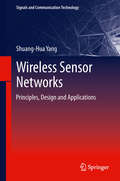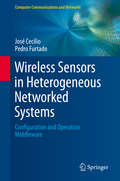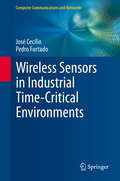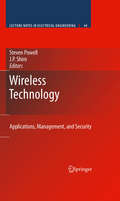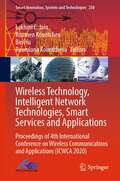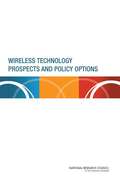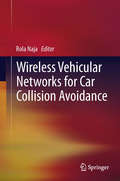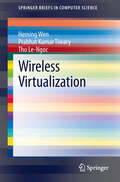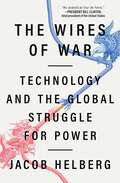- Table View
- List View
Wireless Sensor and Mobile Ad-Hoc Networks
by Driss Benhaddou Ala Al-FuqahaWireless sensor Networks: Vehicle and Space Applications describes the practical perspectives in using wireless sensor networks (WSN) to develop real world applications that can be used for space exploration. These applications include sensor interfaces, remote wireless vehicles, space crew health monitoring and instrumentation. The material discusses how applications of WSN originally developed for space travel and exploration are being applied and used in multiple real world applications, allowing for the development of smart systems that have characteristics such as self healing, self diagnosis, and emergency healthcare notification.
Wireless Sensor Multimedia Networks: Architectures, Protocols, and Applications
by Mohamed Mostafa A. Azim Xiaohong JiangWireless sensor networks (WSNs) are a special class of ad hoc network in which network nodes composed of tiny sensors pass data such as temperature, pressure, and humidity through the network to a central location. Wireless sensor multimedia networks (WSMNs) are a special category of WSNs in which the sensor nodes are small cameras and microphones
Wireless Sensor Networks: Architectures and Protocols (Internet And Communications)
by Edgar Callaway Jr.Because they provide practical machine-to-machine communication at a very low cost, the popularity of wireless sensor networks is expected to skyrocket in the next few years, duplicating the recent explosion of wireless LANs. Wireless Sensor Networks: Architectures and Protocols describes how to build these networks.
Wireless Sensor Networks
by Cailian Chen Shanying Zhu Xinping Guan Xuemin Sherman ShenThis SpringerBrief evaluates the cooperative effort of sensor nodes to accomplish high-level tasks with sensing, data processing and communication. The metrics of network-wide convergence, unbiasedness, consistency and optimality are discussed through network topology, distributed estimation algorithms and consensus strategy. Systematic analysis reveals that proper deployment of sensor nodes and a small number of low-cost relays (without sensing function) can speed up the information fusion and thus improve the estimation capability of wireless sensor networks (WSNs). This brief also investigates the spatial distribution of sensor nodes and basic scalable estimation algorithms, the consensus-based estimation capability for a class of relay assisted sensor networks with asymmetric communication topology, and the problem of filter design for mobile target tracking over WSNs. From the system perspective, the network topology is closely related to the capability and efficiency of network-wide scalable distributed estimation. Wireless Sensor Networks: Distributed Consensus Estimation is a valuable resource for researchers and professionals working in wireless communications, networks and distributed computing. Advanced-level students studying computer science and electrical engineering will also find the content helpful.
Wireless Sensor Networks: 15th China Conference, CWSN 2021, Guilin, China, October 22–25, 2021, Revised Selected Papers (Communications in Computer and Information Science #1509)
by Li Cui Xiaolan XieThis book constitutes the refereed proceedings of the 15th China Conference on Wireless Sensor Networks, CWSN 2021 held in Guilin, China, in October 2021.The 19 papers were carefully reviewed and selected from 60 submissions. The papers are organized in topical sections on theory and technology on wireless sensor network; application on internet of things; security and privacy protection on internet of things; fog computing and wireless computing.
Wireless Sensor Networks: Evolutionary Algorithms for Optimizing Performance
by Damodar Reddy Edla Mahesh Chowdary Kongara Amruta Lipare Venkatanareshbabu Kuppili Kannadasan KWireless Sensor Networks: Evolutionary Algorithms for Optimizing Performance provides an integrative overview of bio-inspired algorithms and their applications in the area of Wireless Sensor Networks (WSN). Along with the usage of the WSN, the number of risks and challenges occurs while deploying any WSN. Therefore, to defeat these challenges some of the bio-inspired algorithms are applied and discussed in this book. Discussion includes a broad, integrated perspective on various challenges and issues in WSN and also impact of bio-inspired algorithms on the lifetime of the WSN. It creates interdisciplinary theory, concepts, definitions, models and findings involved in WSN and Bio-inspired algorithms making it an essential guide and reference. It includes various WSN examples making the book accessible to a broader interdisciplinary readership. The book offers comprehensive coverage of the most essential topics, including: Evolutionary algorithms Swarm intelligence Hybrid algorithms Energy efficiency in WSN Load balancing of gateways Localization Clustering and routing Designing fitness functions according to the issues in WSN. The book explains about practices of shuffled complex evolution algorithm, shuffled frog leaping algorithm, particle swarm optimization and dolphin swarm optimization to defeat various challenges in WSN. The author elucidates how we must transform our thinking, illuminating the benefits and opportunities offered by bio-inspired approaches to innovation and learning in the area of WSN. This book serves as a reference book for scientific investigators who shows an interest in evolutionary computation and swarm intelligence as well as issues and challenges in WSN.
Wireless Sensor Networks: Energy Harvesting and Management for Research and Industry (Signals and Communication Technology)
by Hossam Mahmoud FahmyThis second book by the author on WSNs focuses on the concepts of energy, and energy harvesting and management techniques. Definitions and terminologies are made clear without leaning on the relaxing assumption that they are already known or easily reachable, the reader is not to be diverted from the main course. Neatly drawn figures assist in viewing and imagining the offered topics. To make energy related topics felt and seen, the adopted technologies as well as their manufacturers are presented in details. With such a depth, this book is intended for a wide audience, it is meant to be helper and motivator, for the senior undergraduates, postgraduates, researchers, and practitioners; concepts and energy related applications are laid out, research and practical issues are backed by appropriate literature, and new trends are put under focus. For senior undergraduate students, it familiarizes with conceptual foundations and practical projects implementations. Also, it is intended for graduate students working on their thesis and in need of specific knowledge on WSNs and the related energy harvesting and management techniques. Moreover, it is targeting researchers and practitioners interested in features and applications of WSNs, and on the available energy harvesting and management projects and testbeds. Exercises at the end of each chapter are not just questions and answers; they are not limited to recapitulate ideas. Their design objective is not bound to be a methodical review of the provided concepts, but rather as a motivator for lot more of searching, finding, and comparing beyond what has been presented in the book.
Wireless Sensor Networks: 14th China Conference, CWSN 2020, Dunhuang, China, September 18–21, 2020, Revised Selected Papers (Communications in Computer and Information Science #1321)
by Zhanjun Hao Xiaochao Dang Honghong Chen Fenfang LiThis book constitutes the refereed proceedings of the 14th China Conference on Wireless Sensor Networks, CWSN 2020 held in Dunhuang, China, in September 2020.The 20 full papers were carefully reviewed and selected from 85 submissions. The papers are organized in topical sections on wireless sensor network theory and technology, basic theory and application of internet of things, internet of things security and privacy protection, and perception and positioning.
Wireless Sensor Networks
by Hossam Mahmoud Ahmad FahmyThisbook focuses on the principles of wireless sensor networks (WSNs), theirapplications, and their analysis tools, with meticulous attention paid todefinitions and terminology. This book presents the adopted technologies andtheir manufacturers in detail, making WSNs tangible for the reader. Inintroductory computer networking books, chapter sequencing follows thebottom-up or top-down architecture of the 7-layer protocol. This bookaddresses subsequent steps in this process, both horizontally and vertically,thus fostering a clearer and deeper understanding through chapters thatelaborate on WSN concepts and issues. With such depth, this book is intended for a wide audience; it ismeant to be a helper and motivator for senior undergraduates, postgraduates,researchers, and practitioners. It lays out important concepts and WSN-relateapplications; uses appropriate literature to back research and practicalissues; and focuses on new trends. Senior undergraduate students can use it tofamiliarize themselves with conceptual foundations and practical projectimplementations. For graduate students and researchers, test beds andsimulators provide vital insights into analysis methods and tools for WSNs. Lastly, in addition to applications and deployment, practitioners will be ableto learn more about WSN manufacturers and components within several platformsand test beds.
Wireless Sensor Networks: Current Status and Future Trends
by Shafiullah Khan Al-Sakib Khan Pathan Nabil Ali AlrajehWireless sensor networks (WSNs) utilize fast, cheap, and effective applications to imitate the human intelligence capability of sensing on a wider distributed scale. But acquiring data from the deployment area of a WSN is not always easy and multiple issues arise, including the limited resources of sensor devices run with one-time batteries. Additi
Wireless Sensor Networks: 13th China Conference, CWSN 2019, Chongqing, China, October 12–14, 2019, Revised Selected Papers (Communications in Computer and Information Science #1101)
by Kai Liu Chao Chen Songtao Guo Hongyu HuangThis book constitutes the refereed proceedings of the 13th China Conference on Wireless Sensor Networks, CWSN 2019, held in Chongqing, China, in October 2019. The 27 full papers were carefully reviewed and selected from 158 submissions. The papers are organized in topical sections on fundamentals on Internet of Things; applications on Internet of Things; and IntelliSense, location and tracking.
Wireless Sensor Networks: 16th China Conference, CWSN 2022, Guangzhou, China, November 10–13, 2022, Proceedings (Communications in Computer and Information Science #1715)
by Huadong Ma Xue Wang Lianglun Cheng Li Cui Liang Liu An ZengThis book constitutes the refereed proceedings of the 16th China Conference on Wireless Sensor Networks, CWSN 2022, which took place in Guangzhou, China, in November 2022. The 17 full papers presented in this volume were carefully reviewed and selected from 204 submissions, including 87 English papers and 117 Chinese papers. The conference provided an academic exchange of research and a development forum for IoT researchers, developers, enterprises, and users. Exchanging results and experience of research and applications in IoT, and discussing the key challenges and research hotspots, is the main goal of the forum. As a high-level forum for the design, implementation, and application of IoT, the conference promoted the exchange and application of the oriesand technologies of IoT-related topics.
Wireless Sensor Networks
by Rastko R. Selmic Vir V. Phoha Abdul SerwaddaThis book presents a comprehensive overview of wireless sensor networks (WSNs) with an emphasis on security, coverage, and localization. It offers a structural treatment of WSN building blocks including hardware and protocol architectures and also provides a systems-level view of how WSNs operate. These building blocks will allow readers to program specialized applications and conduct research in advanced topics. A brief introductory chapter covers common applications and communication protocols for WSNs. Next, the authors review basic mathematical models such as Voroni diagrams and Delaunay triangulations. Sensor principles, hardware structure, and medium access protocols are examined. Security challenges ranging from defense strategies to network robustness are explored, along with quality of service measures. Finally, this book discusses recent developments and future directions in WSN platforms. Each chapter concludes with classroom-tested exercises that reinforce key concepts. This book is suitable for researchers and for practitioners in industry. Advanced-level students in electrical engineering and computer science will also find the content helpful as a textbook or reference.
Wireless Sensor Networks: 12th China Conference, Cwsn 2018 Kunming, China, September 21-23, 2018, Revised Selected Papers (Communications in Computer and Information Science #984)
by Shikai Shen Kaiguo Qian Shaojun Yu Wu WangThis book constitutes the refereed proceedings of the 12th China Conference on Wireless Sensor Networks, CWSN 2018, held in Kunming, China, in September 2018. <P><P> The 16 revised full papers were carefully reviewed and selected from 177 submissions. The papers are organized in topical sections on algorithm for wireless sensor network; positioning and location; neural network; energy efficiency and harvesting; privacy and security; image processing.
Wireless Sensor Networks: 17th China Conference, CWSN 2023, Dalian, China, October 13–15, 2023, Proceedings (Communications in Computer and Information Science #1994)
by Lei Wang Tie Qiu Chi Lin Xinbing WangThis book constitutes the refereed proceedings of the 17th China Conference on Wireless Sensor Networks, CWSN 2023, which took place in Dalian, China, in October 2023. The 22 full papers presented in this volume were carefully reviewed and selected from 105 submissions, including 38 English papers and 67 Chinese papers. The conference provided an academic exchange of research and a development forum for IoT researchers, developers, enterprises, and users. Exchanging results and experience of research and applications in IoT, and discussing the key challenges and research hotspots, is the main goal of the forum. As a high-level forum for the design, implementation, and application of IoT, the conference promoted the exchange and application of the theories and technologies of IoT-related topics.
Wireless Sensor Networks: 7th China Conference, Cwsn 2013, Qingdao, China, October 17-19, 2013. Revised Selected Papers (Communications In Computer And Information Science #418)
by Xiaofei Wang Zenghua Zhao Limin Sun Li Cui Keqiu Li Huadong Ma Jianzhong LiThis book constitutes the refereed proceedings of the 11th China Conference on Wireless Sensor Networks, CWSN 2017, held in Tianjin, China, in October 2017. The 28 revised full papers were carefully reviewed and selected from 213 submissions. The papers are organized in topical sections on wireless sensor networks; energy efficiency and harvesting; data fusion; mobile computing and social services.
Wireless Sensor Networks
by Shuang-Hua YangWireless Sensor Networks presents the latest practical solutions to the design issues presented in wireless-sensor-network-based systems. Novel features of the text, distributed throughout, include workable solutions, demonstration systems and case studies of the design and application of wireless sensor networks (WSNs) based on the first-hand research and development experience of the author, and the chapters on real applications: building fire safety protection; smart home automation; and logistics resource management. Case studies and applications illustrate the practical perspectives of: · sensor node design; · embedded software design; · routing algorithms; · sink node positioning; · co-existence with other wireless systems; · data fusion; · security; · indoor location tracking; · integrating with radio-frequency identification; and · Internet of things Wireless Sensor Networks brings together multiple strands of research in the design of WSNs, mainly from software engineering, electronic engineering, and wireless communication perspectives, into an over-arching examination of the subject, benefiting students, field engineers, system developers and IT professionals. The contents have been well used as the teaching material of a course taught at postgraduate level in several universities making it suitable as an advanced text book and a reference book for final-year undergraduate and postgraduate students.
Wireless Sensors in Heterogeneous Networked Systems
by José Cecílio Pedro FurtadoThis book presents an examination of the middleware that can be used to configure and operate heterogeneous node platforms and sensor networks. The middleware requirements for a range of application scenarios are compared and analysed. The text then defines middleware architecture that has been integrated in an approach demonstrated live in a refinery. Features: presents a thorough introduction to the major concepts behind wireless sensor networks (WSNs); reviews the various application scenarios and existing middleware solutions for WSNs; discusses the middleware mechanisms necessary for heterogeneous WSNs; provides a detailed examination of platform-agnostic middleware architecture, including important implementation details; investigates the programming paradigms for WSNs, and for heterogeneous sensor networks in general; describes the results of extensive experimentation and testing, demonstrating that the generic architecture is viable for implementation on multiple platforms.
Wireless Sensors in Industrial Time-Critical Environments
by José Cecílio Pedro FurtadoThis book introduces the fundamentals of DCS, and shows how to include wireless technology in their design while guaranteeing the desired operation characteristics. The text also presents insights and results gained from extensive practical experience in implementing and testing systems within a specific industrial setting. Features: examines the operations that the DCS implements, covering human-machine interfaces, diagnostics and maintenance interfaces, and controllers; discusses industrial control system and wireless network protocols; reviews scheduling in wireless sensor networks; describes a latency model for heterogeneous DCS with wired and wireless parts, that predicts monitoring, command, and closed loop latencies; explains how to plan operation timings systematically; introduces measures and metrics for performance monitoring and debugging, and describes how to add these to a system; presents experimental results to validate the planning approach, based on an application test-bed.
Wireless Technology
by Steven Powell J. P. ShimThis is an edited volume based on selected papers from the annual Wireless Telecommunications Symposium. The WTS is a forum to exchange information on advances in mobile communications and wireless networking technology, management, applications, and security in a conference environment with leaders and experts from industry, governmental agencies, and universities around the world. The key topics from the symposium include: 1) Wireless Network Security, 2) Advances in Satellite Communications, 3) New Wireless Communications Ventures, 4) Wireless Communications Investments, 5) Mobile Wireless Services and Business, 6) Future Directions in Wireless Communications Research. The best papers from the conference were selected, expanded, and edited to produce this cohesive volume.
Wireless Technology, Intelligent Network Technologies, Smart Services and Applications: Proceedings of 4th International Conference on Wireless Communications and Applications (ICWCA 2020) (Smart Innovation, Systems and Technologies #258)
by Lakhmi C. Jain Roumen Kountchev Bin Hu Roumiana KountchevaThis book gathers selected papers presented at the 4th International Conference on Wireless Communications and Applications (ICWCA 2020), held at Hainan University, China. The second volume will involve research works aimed at the contemporary applications: emerging wireless/mobile applications, context and location-aware wireless services; wireless telemedicine and e-health services; intelligent transportation systems; RFID technology and application; cognitive radio and sensor-based applications; content distribution in wireless home environment and many others.
Wireless Technology Prospects and Policy Options
by National Research Council of the National AcademiesThe use of radio-frequency communication--commonly referred to as wireless communication--is becoming more pervasive as well as more economically and socially important. Technological progress over many decades has enabled the deployment of several successive generations of cellular telephone technology, which is now used by many billions of people worldwide; the near-universal addition of wireless local area networking to personal computers; and a proliferation of actual and proposed uses of wireless communications. The flood of new technologies, applications, and markets has also opened up opportunities for examining and adjusting the policy framework that currently governs the management and use of the spectrum and the institutions involved in it, and models for allocating spectrum and charging for it have come under increasing scrutiny. Yet even as many agree that further change to the policy framework is needed, there is debate about precisely how the overall framework should be changed, what trajectory its evolution should follow, and how dramatic or rapid the change should be. Many groups have opinions, positions, demands, and desires related to these questions--reflecting multiple commercial, social, and political agendas and a mix of technical, economic, and social perspectives. The development of technologies and associated policy and regulatory regimes are often closely coupled, an interplay apparent as early as the 1910s, when spectrum policy emerged in response to the growth of radio communications. As outlined in this report, current and ongoing technological advances suggest the need for a careful reassessment of the assumptions that inform spectrum policy in the United States today. This book seeks to shine a spotlight on 21st-century technology trends and to outline the implications of emerging technologies for spectrum management in ways that the committee hopes will be useful to those setting future spectrum policy.
Wireless Vehicular Networks for Car Collision Avoidance
by Rola NajaWireless Vehicular Networks for Car Collision Avoidance focuses on the development of the ITS (Intelligent Transportation Systems) in order to minimize vehicular accidents. The book presents and analyses a range of concrete accident scenarios while examining the causes of vehicular collision and proposing countermeasures based on wireless vehicular networks.The book also describes the vehicular network standards and quality of service mechanisms focusing on improving critical dissemination of safety information. With recommendations on techniques and protocols to consider when improving road safety policies in order to minimize crashes and collision risks.
Wireless Virtualization
by Heming Wen Prabhat Kumar Tiwary Tho Le-NgocThis SpringerBriefs is an overview of the emerging field of wireless access and mobile network virtualization. It provides a clear and relevant picture of the current virtualization trends in wireless technologies by summarizing and comparing different architectures, techniques and technologies applicable to a future virtualized wireless network infrastructure. The readers are exposed to a short walkthrough of the future Internet initiative and network virtualization technologies in order to understand the potential role of wireless virtualization in the broader context of next-generation ubiquitous networks. Three main wireless virtualization perspectives are explored, along with the potential challenges and requirements of a sustainable wireless virtualization framework. Finally, it presents an example of a multi-perspective wireless virtualization framework. The readers learn the latest concepts in the application of wireless virtualization as well as its relationship with cutting-edge wireless technologies such as software-defined radio (SDR) and cognitive radio.
The Wires of War: Technology and the Global Struggle for Power
by Jacob HelbergFrom the former news policy lead at Google, an urgent and groundbreaking account of the high-stakes global cyberwar brewing between Western democracies and the autocracies of China and Russia that could potentially crush democracy.From 2016 to 2020, Jacob Helberg led Google&’s global internal product policy efforts to combat disinformation and foreign interference. During this time, he found himself in the midst of what can only be described as a quickly escalating two-front technology cold war between democracy and autocracy. On the front-end, we&’re fighting to control the software—applications, news information, social media platforms, and more—of what we see on the screens of our computers, tablets, and phones, a clash which started out primarily with Russia but now increasingly includes China and Iran. Even more ominously, we&’re also engaged in a hidden back-end battle—largely with China—to control the Internet&’s hardware, which includes devices like cellular phones, satellites, fiber-optic cables, and 5G networks. This tech-fueled war will shape the world&’s balance of power for the coming century as autocracies exploit twenty-first-century methods to re-divide the world into twentieth century-style spheres of influence. Helberg cautions that the spoils of this fight are power over every meaningful aspect of our lives, including our economy, our infrastructure, our national security, and ultimately, our national sovereignty. Without a firm partnership with the government, Silicon Valley is unable to protect democracy from the autocrats looking to sabotage it from Beijing to Moscow and Tehran. The stakes of the ongoing cyberwar are no less than our nation&’s capacity to chart its own future, the freedom of our democratic allies, and even the ability of each of us to control our own fates, Helberg says. And time is quickly running out.
